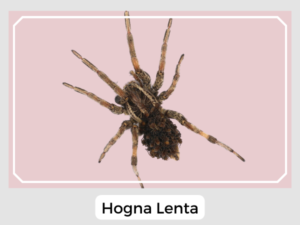The Hogna lenta is a kind of wolf spider that lives mostly in the USA. It’s a member of the big wolf spider family. People who study spiders and nature lovers find it really interesting because of the way they act and how they look. In this post, we’ll share cool facts about the Hogna lenta spider. Ready to hop into the spider world? Let’s go!
Roughly 1-2 weeks post-mating, the female spins a protective sac containing the fertilized eggs. This sac is securely attached to the spinnerets on her abdomen.
After an incubation period of 5-8 weeks, the spiderlings emerge. These nascent spiders remain relatively inconspicuous, opting to stay on their mother’s back. Within 1-4 weeks, they venture off on their own. Although many may not survive, those who do experience several molts before reaching full maturity.
These spiders do not construct elaborate webbing as they chase after and leap onto their prey. However, they will leave tripwires made of webbing in front of their burrows to alert them.
Yes, Hogna lenta spiders do have venom. They use it to help catch their bug meals. For people, the venom is usually gentle and not too strong.
Yes, Hogna lenta spiders can bite. But they’re often quiet and won’t bite unless they’re really startled or feel threatened.
Spiders play a crucial role in maintaining the ecological balance. Hogna lenta, in particular, helps regulate insect populations. Their preference for beetles, crickets, mealworms, and waxworms ensures these insect numbers are kept in check, promoting a healthy environment.
Natural Predator
Birds, larger spiders, and some reptiles are known to prey on Hogna lenta, showcasing nature’s delicate balance between predator and prey.
Prey-Predator Dynamics:
While the Hogna lenta actively hunts various insects, they too must remain vigilant. Their tripwire mechanism in front of burrows is not just for their prey but also alerts them of potential threats.
Relationship with Humans:
For the most part, Hogna lenta is harmless to humans. Their venom might cause discomfort but is not life-threatening. While their defensive postures can seem threatening, they are more of a demonstration than an actual intent to harm. Understanding their role in the ecosystem can foster a more harmonious coexistence.
| Lifespan | Approximately 1 year. |
| Distribution | Mainly found in the United States. |
| Habitat | Prefers the dense foliage of shrubbery and forests. |
| Diet | Mainly feasts on beetles, crickets, mealworms, and waxworms. |

The Hogna lenta is a kind of wolf spider that lives mostly in the USA. It’s a member of the big wolf spider family. People who study spiders and nature lovers find it really interesting because of the way they act and how they look. In this post, we’ll share cool facts about the Hogna lenta spider. Ready to hop into the spider world? Let’s go!
Roughly 1-2 weeks post-mating, the female spins a protective sac containing the fertilized eggs. This sac is securely attached to the spinnerets on her abdomen.
After an incubation period of 5-8 weeks, the spiderlings emerge. These nascent spiders remain relatively inconspicuous, opting to stay on their mother’s back. Within 1-4 weeks, they venture off on their own. Although many may not survive, those who do experience several molts before reaching full maturity.
These spiders do not construct elaborate webbing as they chase after and leap onto their prey. However, they will leave tripwires made of webbing in front of their burrows to alert them.
Yes, Hogna lenta spiders do have venom. They use it to help catch their bug meals. For people, the venom is usually gentle and not too strong.
Yes, Hogna lenta spiders can bite. But they’re often quiet and won’t bite unless they’re really startled or feel threatened.
Spiders play a crucial role in maintaining the ecological balance. Hogna lenta, in particular, helps regulate insect populations. Their preference for beetles, crickets, mealworms, and waxworms ensures these insect numbers are kept in check, promoting a healthy environment.
Natural Predator
Birds, larger spiders, and some reptiles are known to prey on Hogna lenta, showcasing nature’s delicate balance between predator and prey.
Prey-Predator Dynamics:
While the Hogna lenta actively hunts various insects, they too must remain vigilant. Their tripwire mechanism in front of burrows is not just for their prey but also alerts them of potential threats.
Relationship with Humans:
For the most part, Hogna lenta is harmless to humans. Their venom might cause discomfort but is not life-threatening. While their defensive postures can seem threatening, they are more of a demonstration than an actual intent to harm. Understanding their role in the ecosystem can foster a more harmonious coexistence.
| Lifespan | Approximately 1 year. |
| Distribution | Mainly found in the United States. |
| Habitat | Prefers the dense foliage of shrubbery and forests. |
| Diet | Mainly feasts on beetles, crickets, mealworms, and waxworms. |
